|
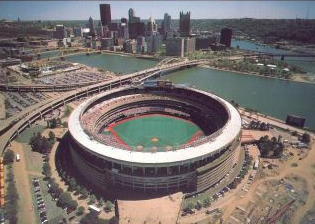 
Three Rivers Stadium was one of the
main items in the transformation of the Pittsburgh riverfront from an industrial
center into a showcase attraction to highlight the Golden Triangle. Conceived
in the 1950s during Renaissance I as a replacement for aging Forbes
Field, many different
designs were debated.
One interesting design submitted in 1958 envisioned a stadium built on the Monongahela
River. The Smithfield Street Bridge would be replaced by a massive span,
complete with adjoining parking and hotel, along with the stadium. The
complex would be built entirely above water.

A proposal submitted in 1958 for a
Pittsburgh stadium built entirely above the Monongahela River.
Eventually, the north shore was
chosen as the spot for the new "Pittsburgh Stadium." The complex would
include hotels, restaurants and a riverfront park to complement the new
state-of-the-art multi-purpose stadium.
The original prototype was a bit different
from the final design. It was round with an open end facing the city. Due to cost
constraints, this design was modified into the cookie-cutter shape.

The original prototype model for
Pittsburgh Stadium. The open end was closed in the final design.
Although the hotel and restaurant
development never materialized, the stadium that was to be the centerpiece
of the north shore renaissance was built. Ground was broken in April of 1968
and construction was completed in June of 1970. The cost of the stadium was
$55 million.
In between the ground-breaking
and the completion of construction, the structure was given a new name,
"Three Rivers Stadium." The Pirates left Forbes
Field after sixty-one years
and moved into their new home in July 1970. The Steelers eagerly followed that
fall.

Championship Turf
The Pirates made playoff appearances in
five of their first six seasons at Three Rivers. Manager Danny Murtaugh and
"The Lumber Company" captured a World Series title in 1971. Pirate legend
Roberto Clemente got his 3000th and final hit during the last home game of the
1972 season.
Pitcher John Candelaria threw the first
no-hitter in 1976 and the Buccos gained another title in 1979 with Manager Chuck
Tanner, Captain Willie Stargell and "The Family".

The first game played in Three Rivers
Stadium took place on July 16, 1970.
The Pirates of the early 1990s again
brought the National League Championship series to the home turf. Manager Jim
Leyland and the "Killer Bees", featuring Barry Bonds and Bobby Bonilla, came
up short of the World Series three consecutive years. The 1993 season was the
final time the Pirates compiled a winning record at Three Rivers Stadium.

The blimp flies over Pittsburgh while Three
Rivers Stadium hosts a National League
Championship game between the Pirates and Braves on October 9, 1991.
The Steelers also made the most of their
new home field. Franco Harris made the Immaculate Reception at home during the
1972 playoffs, arguably the greatest play in NFL history.
In 1974, Coach Chuck
Noll and his gridiron juggernaut captured the first of four Vince Lombardi Trophies
earned during the 1970s. The Steelers engaged in three epic AFC championship games
against the Oakland Raiders (1975) and Houston Oilers (1978 and 1979).
 
In 1979, all eyes were on the Pirates, the
Steelers, and the "City of Champions".
In what many called home field advantage,
these battles were all fought on frozen turf; perfect Steeler football weather.
The Steelers adorned the stadium facade with the Roman Numerals IX, X, XIII and XIV.
Pittsburgh became known as the "City of Champions". Three Rivers Stadium, now an icon to sports fans
around the globe, was championship turf and the place to be.
Houston Oiler Coach Bum Phillips, after
failing in the AFC championship two years in a row, uttered in frustration, "The
road to the Super Bowl runs through Pittsburgh."

During the 1970s, no truer words
were spoken. The Steel Curtain, led by "Mean" Joe Greene, Dwight White, Ernie Holmes,
and L.C. Greenwood was adept at stopping all traffic. In the 1975 Pro Bowl, eight
of eleven defensive starters were Pittsburgh Steelers!
Then, in the 1990s, the Steelers brought
the playoff magic back to Pittsburgh under Coach Bill Cowher with an AFC championship
win over the Indianapolis Colts in 1995. The team, led by Rod Woodson and Greg Lloyd,
failed to bring home one-for-the-thumb, losing to the Dallas Cowboys in Super Bowl
XXX.

By the turn of the century,
cookie-cutter type multi-purpose stadiums like Pittsburgh's Three Rivers
Stadium, Philadelphia's Veterans Stadium and Cincinnati's Riverfront Stadium
were no longer financially or aesthetically pleasing to the professional sports
world.
On February 11, 2001, the 33-year reign of
Pittsburgh's Stadium of Champions came to an end. Three Rivers Stadium came crashing
down in a thunderous, controlled implosion to make way for the Pirates PNC Park and the Steelers Heinz Field.

The Pittsburgh Pirates play the Montreal
Expos at Three Rivers Stadium in 1974.
Wikipedia: Three Rivers Stadium.
 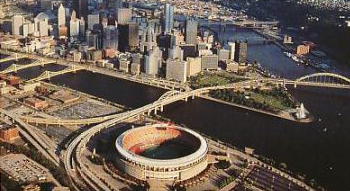
The Beginning and The End

The North Shore location, in the
late-1950s, that will a decade later be the site of Three Rivers
Stadium.
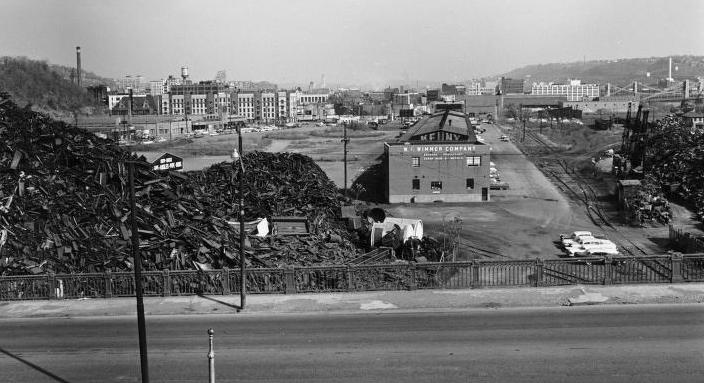
In 1963, the initial clearing of the
land on the north shore began.

The North Shore in January 1964. The
stadium would be located between the two bridges.

A commemorative Zippo lighter given to
Post-Gazette writer Dan McGibbeny.

By April 1968 it was time to begin work on
Pittsburgh's new sports stadium. Visible is the circular foundation.

One year after the groundbreaking, on April 20,
1969, the stadium is taking shape.


Things had progressed nicely by December 10,
1969, when the last of the upper frame was lowered into place.
The U.S. Steel Building, shown in the background, is under construction at the
time.

Three Rivers Stadium in the early spring
of 1970. It took two years to complete construction.
It took nearly as long to reach a final concensus on a new name. After much
deliberation, the agreed upon name was "Three Rivers Stadium."

Seven years after the initial clearing of
land on the North Shore, on July 16, 1970, the Pirates played their
first game on their new home field. The stadium would stand for thirty-one
years.
Fast Forward 33 Years ...
Four Super Bowls - Two World Series
... and a Lifetime Worth of Pittsburgh Sports Memories
* * * * * *
Sunday, February 11, 2001

Curious onlookers gathers at the Point
to watch the Three Rivers Stadium implosion.

Fireworks were set off at the same time
as the implosion.

Three Rivers Stadium, once the pride of
Pittsburgh, disappears in a heap of rubble.
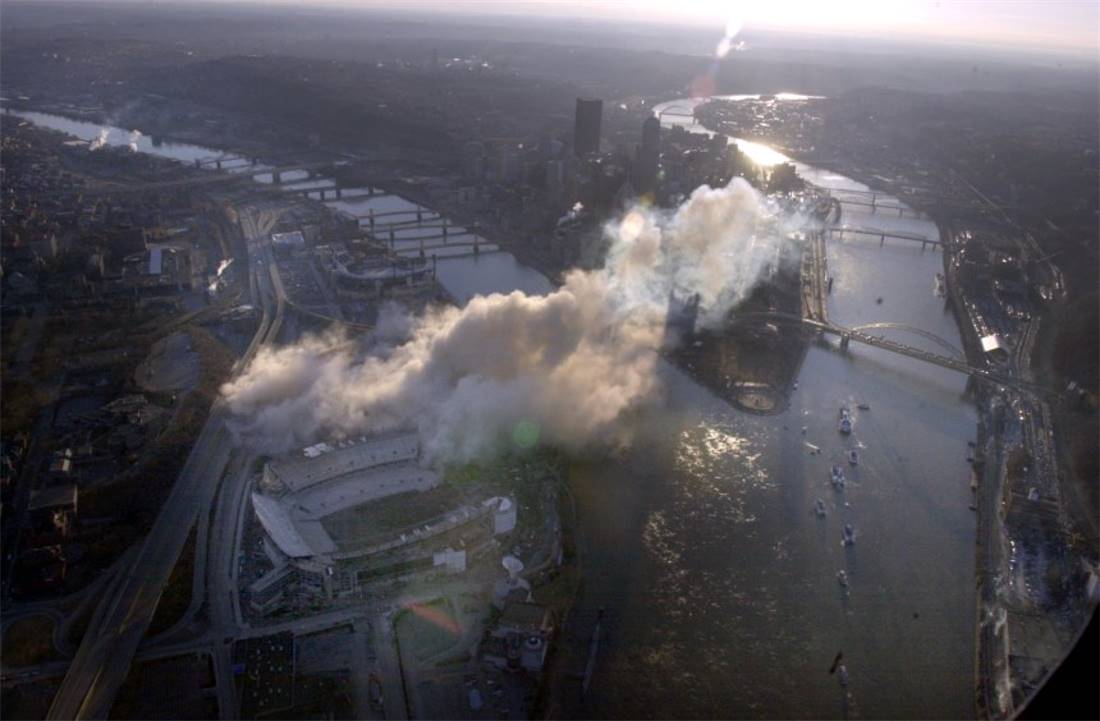
Dust and smoke from the former Three
Rivers Stadium rises over the city of Pittsburgh.

What began as a heap of rubble in 1963
was reduced to another heap of rubble in 2001.
Four Ballparks on the North Shore (1890-present)
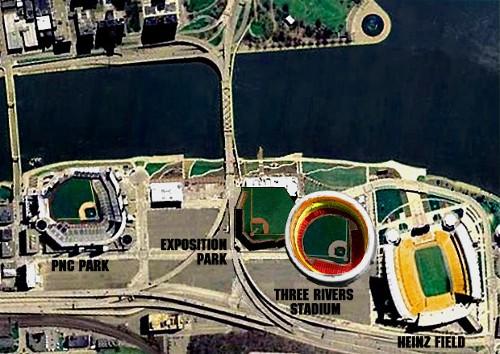
The four stadiums that have occupied the
north shore since 1890. Exposition Park stood until 1915.
Three Rivers was there from 1968 to 2001. The current stadiums, PNC Park and Heinz Field,
were both built in 2000. Each of the stadiums has a rich Pittsburgh sports
history.
Thanks to Doug Brendel for creating the four-ballpark image.
Childhood Memories at Three Rivers Stadium

A boyhood dream come true!
Having a grandfather who was a sportswriter had its benefits, and
knowing Mr. Klingensmith was icing on the cake. On this special day
I met Manny Sanguillen, Jose Pagan and Willie Stargell. I played
catch with Dave Giusti and got tips on throwing a palmball,
his signature pitch.
This photo with Bill Mazeroski
and Roberto Clemente ranks among my most treasured moments. The Pirates
were on their way to a 1971 World Series triumph and I had just rubbed
hands with two future Hall of Famers!
Years later, in September 2010,
I was privileged to have the opportunity of writing an article covering
the unveiling of the Bill Mazeroski
statue at PNC Park. Shortly afterwards, Bill Mazeroski was kind enough to
sign the photo.

Here is another cherished memory of Three
Rivers Stadium. The date was June 29, 1973. It was a night game. Pirate batter
Bob Robertson hit a foul ball high into the lights along the first base railing.
Montreal Expo first baseman Mike Jorgensen and eleven year old Doug Brendel both
went for the ball. Brendel edged out Jorgensen, caught the ball and kept a Pirate
rally alive. For his efforts, Doug's achievement was duly noted on the outfield
scoreboard and he was given an Honorary Pirate Contract. Doug still has the
contract and the ball.

Pittsburgh Pirate Yearbooks/Scorebooks (1951-1995)

A collage of Pittsburgh Pirates yearbooks,
and a few scorebooks, covering the years 1951 through 1995.
Click on image for a larger file showing the detailed artwork by such
artists as Jack Berger and Cy Hungerford.
|